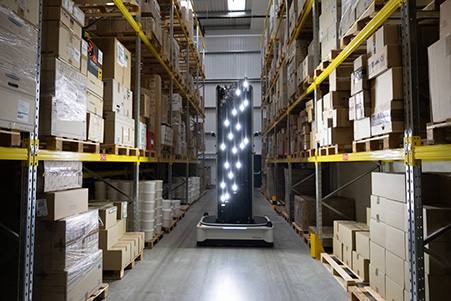Warehouses must adapt to evolving needs through robotics integration that enhance efficiency, reduce costs, and meet rising demands.
By Andrei Danescu, CEO and Co-Founder of Dexory
Warehouses are in the middle of undergoing a transformative change caused by the need for greater productivity, efficiency, accuracy, and scalability. This change is evident in the emergence of robotics and automation as a critical tool to meet these changing demands. Warehouse robotics have re-defined logistic operations, order processing, and inventory management. As businesses strive to meet increasing consumer expectations and the demands of e-commerce, adopting robotic solutions has become a strategic necessity.
Automation has the long-term impact of minimizing labor costs, error reductions, and improved resource utilization making the larger upfront investment well worth its price. Companies that choose to adapt and take the time to integrate robotics into their everyday warehousing operations can expect to see a noticeable reduction in overall operating costs, making it a significant financial advantage in the long run, reinforcing the value of these solutions.

Through a reduction of manual errors and increased speed, automation has the power to enhance efficiency and productivity. This can be seen in various ways such as, accelerating order picking, sorting, and packing creating the opportunity for warehouses to process larger orders and decrease lead times. This advanced technology streamlines operations creating significant gains in efficiency. Research indicates that automation is seen as key to warehousing efficiency, with 70% of supply chain professionals recognizing its benefits. This demonstrates the growing role of automation and robotics in transforming warehouse operations.
Integrating automation into manual tasks that are repetitive or labor-intensive can foster new synergies between humans and robots that result in greater overall productivity. Robotics provides the opportunity to free up time for human employees to focus on higher-value activities that require problem solving and critical thinking and skills. A report by Kardex found that automation boosts productivity by enabling one worker to handle multiple tasks, freeing up two thirds of the workforce without reducing throughput. This underscores the benefits of automation in improving overall operational efficiency.
With the recent surge in not only online shopping, but also in faster order fulfillment needs, traditional manual processes have become insufficient. Warehouses must adapt their operations to meet the demands of higher order volumes and tighter delivery windows. Robotic systems help meet this gap through increased accuracy, scalability, and speed. A recent report found that 68% of consumers look for shorter delivery windows at checkout and 55% are willing to pay more for same-day delivery. This highlights the need for companies to employ automation in order to meet these demands in order to maintain customer satisfaction and loyalty.
Businesses are faced with growing challenges when it comes to the warehousing sector, challenges that have pushed robotics to the forefront of operations, making it a necessity when sustaining competitive advantage. Organizations that choose to invest in automation position themselves for long-term success through cost savings, increased efficiency, maximized productivity, and meeting evolving consumer demands. As the logistics landscape advances, robotics and automation will continue to set the pace for navigating modern supply chain complexities with agility, efficiency, and precision.

About the Author:
Andrei Danescu is the CEO and co-founder of Dexory, a London-based company specializing in autonomous robotics and AI solutions within the warehousing and logistics industry. With a deep passion for engineering and a background in Systems Engineering and Autonomous Technology, he built his first robot in 2004. Andrei is always on the lookout for new ways to introduce revolutionary autonomous robots into the world.
Read more from the author:
Navigating The Complexities of Supply Chains Ahead of Peak Season | Supply and Demand Chain Executive, November 1, 2024
The Future of Robotics: From Science Fiction to Industry Redefining Technology | Quality Magazine, November 20, 2024
In this episode, I sat down with Beejan Giga, Director | Partner and Caleb Emerson, Senior Results Manager at Carpedia International. We discussed the insights behind their recent Industry Today article, “Thinking Three Moves Ahead” and together we explored how manufacturers can plan more strategically, align with their suppliers, and build the operational discipline needed to support intentional, sustainable growth. It was a conversation packed with practical perspectives on navigating a fast-changing industry landscape.